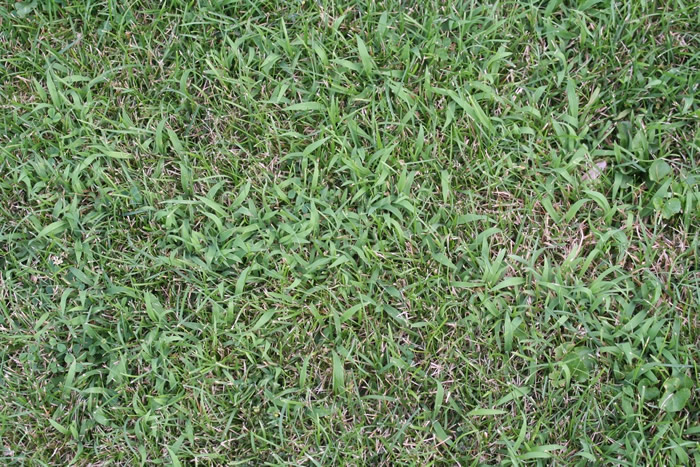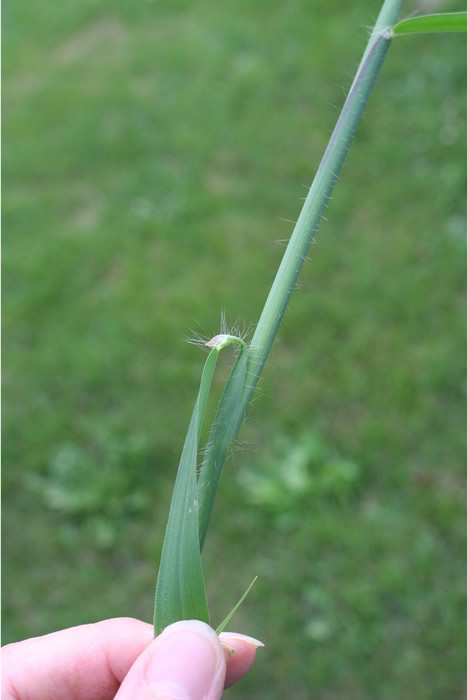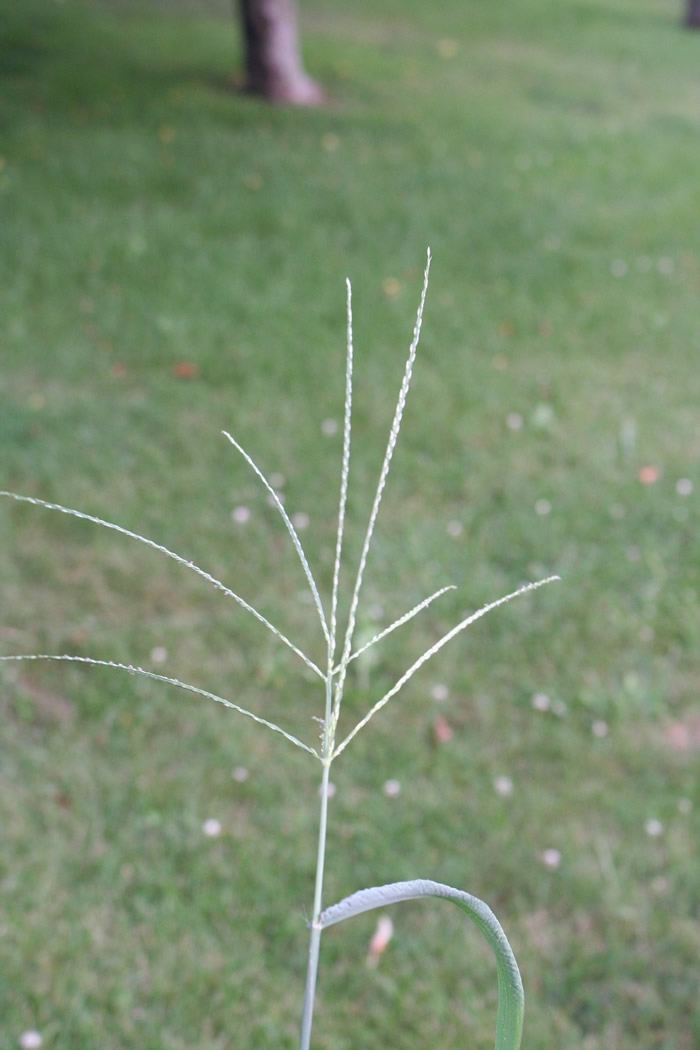Issue 8, July 29, 2020
Crabgrass: Controlling This Season-Long Germinator
When there is an unknown weedy grass growing in a lawn, often crabgrass is quickly and inaccurately blamed. Further investigation typically reveals that the offending grass is often quackgrass or tall fescue. This week I saw the tables flip while some plant enthusiasts online were discussing the possible identification of a mystery seedling grass. Because it is late July, crabgrass was quickly ruled out and the fingers pointed instead towards quackgrass. Without any haste, control recommendations then moved that direction. When crabgrass is improperly blamed, I often think, “poor crabgrass” but this time found myself thinking, “poor quackgrass”.
Crabgrass is often thought of as being a spring emerging weed. However, with the recent rains, we are reminded that crabgrass can germinate all during the growing season provided there is adequate moisture. Where I live, we have been dry for several weeks and turfgrass growth greatly slowed, but the inch of rain we received a week ago was just what the crabgrass seeds needed. We are also reminded that crabgrass is an abundant seed producer as evidenced by the large seedling populations easily found now in central Ilinois. By now, many spring applied crabgrass preventers have degraded and are likely no longer doing their intended job.

Crabgrass seedlings growing in a lawn. Credit: Michelle Wiesbrook
Crabgrass is a warm season annual weed. Reproduction is by seed and it is not capable of overwintering in Illinois. So, plants will always begin as seedlings. Most crabgrass seeds germinate when soil temperatures are in the mid 60’s for about 3 to 6 consecutive days. However, crabgrass seeds are capable of germinating from very early in the spring to very late in the fall as long as adequate soil moisture is present. Plants that germinate in the fall will have a short life as a hard frost will kill them. In cool season lawns, brown patches will typically be left behind.

Crabgrass in October after frost. Credit: Michelle Wiesbrook
Crabgrass stems can grow ascending to more than 3 feet in height but more typically grow prostrate, forming a mat. They are often purplish near the base and can root at the nodes. All of this tillering makes the plant very difficult to hand pull without the plant breaking off at the base of the soil. The ligule is jagged and membraneous. The leaves are pale blue–green (often bright green), hairy on both sides, flat, sharply pointed, 1/4 to 2/5 inch wide, 2 to 6 inches long, and with margins that may be rough. The leaf sheath is densely hairy. The flowers are borne in a raceme with 3 to 13 purplish, fingerlike spikes up to 6 inches long. They occur in whorls at the ends of stout stalks during August and September. Both large crabgrass (Digitaria sanguinalis) and smooth crabgrass (D. ischaemum) are commonly found in the Midwest. Although they are similar in appearance, smooth crabgrass tends to be smaller with fewer hairs on the leaves. Collectively, they are commonly referred to as simply being “crabgrass”.

The ligule is jagged and membraneous. Note the stiff hairs. Credit: Michelle Wiesbrook
Crabgrass can be found in most warm, moist, fertile lawns in sun where turf is thin or mowed too short. Often found in so called “hot spots” next to the driveway or sidewalk, it tolerates hot, dry, compacted soils after establishment. This weed may spread aggressively to crowd out desirable grasses.
Maintain turf density and health through proper culture. Avoid spring cultivation, short mowing, summer fertilization, and light, frequent irrigation. In landscape beds, mulch and other weed barriers can be used to block light and thus prevent crabgrass germination. Existing plants can be removed by hand using proper tools to ensure complete removal of tillered plants. Preventing seed production is key.
Crabgrass is best prevented by using a preemergent herbicide prior to seed germination. Irrigation or rainfall is then needed for activation. Apply preemergent herbicides before germination when soil temperatures stabilize at 55°F for several consecutive days. Many are applied in the early spring including the following active ingredients for cool season turfgrass: benefin + trifuralin, dithiopyr, oxadiazon, pendimethalin, prodiamine, quinclorac, siduron, and sulfentrazone. Older chemistry options include bensulide and benefin. Benefin alone will provide only adequate control of crabgrass. Some combination products are available. Dithiopyr will provide additional postemergent control up to the 1-tiller stage. For landscape situations, there are several active ingredients that will result in good or excellent control of crabgrass. Check the product label to ensure that this species is listed.

Postemergent herbicides may be used to control crabgrass that has already emerged from the soil. For landscape situations, a graminicide which is selective for grasses is a good route to take. These can safely be used around a wide variety of broadleaf plants. Check label specifics. Options include: fenoxaprop, fluazifop, sethoxydim, and clethodim. Cool season turfgrass options include: bispyribac-sodium, fenoxaprop, mesotrione, quinclorac, and topramezone. MSMA is approved for use on golf courses and sod farms only. With post herbicides, two applications are typically needed, 2 or 3 weeks apart if crabgrass has tillered. Smaller plants that have yet to tiller are more easily controlled. It is important to consider growth stage or size when selecting a herbicide. Most labels will provide guidance on how well they work on certain leaf or tiller sizes. Be aware that injury can occur to turf if applications are made when temperatures are greater than 85°F. So, if you must spray crabgrass this late in the season, be willing to accept some injury or wait for some cooler forecasted days.
Always carefully read and follow label directions. There may be restrictions on seasonal rate limits, growth stage, turf type, ornamental species, or site of application. A common mistake is to apply too low of a rate. Again, the label will provide guidance. Split or sequential applications of preemergent herbicides are commonly used in turfgrass where the total amount to be applied is divided, with half applied in April and half applied 45-60 days later.
Misidentification can lead to improper control tactics being deployed, with time and money being wasted. As a result, the weed problem remains. Though not really look-a-like species, certain grasses are commonly confused with crabgrass. For more information on identifying tall fescue, Quackgrass, and Johsongrass, please see, “Is It Crabgrass or Something Else” at http://hyg.ipm.illinois.edu/article.php?id=786.
Grasses can be challenging to identify! For assistance, check out Identifying Turf and Weedy Grasses of the Northern United States. This pocket-sized guide is available for sale at: pubsplus.illinois.edu.
Author:
Michelle Wiesbrook